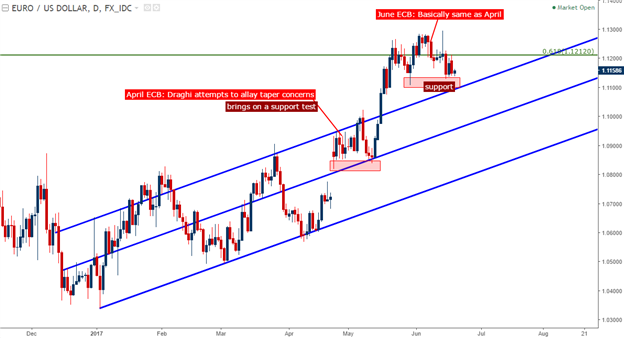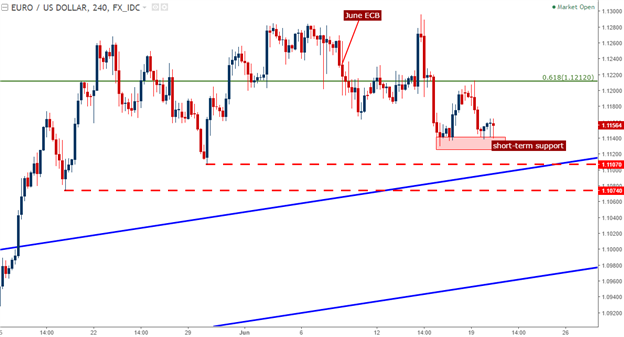The U.S. Dollar may be near a turning point. While price action in DXY continues above the 97.50 level that we outlined yesterday, bulls appear unenthused as we’ve seen a lack of follow-thru demand as resistance faces deeper tests. But this strength appears to be asymmetric, as some major pairings are showing more of this recent theme than others. Below, we look at the majors in order to determine which markets may be primed for a continuation of USD-strength, and which may be more interesting for ‘fade’ setups in the Greenback.
EUR/USD
The Euro has been rather resilient after an ECB rate decision earlier in the month saw the bank take a very dovish stance. This syncs very well with a similar scenario in latter April, after the topside breakout from the first round of French elections. In April, much as we saw in June, Mario Draghi attempted to talk-down the prospect of stimulus exit in an apparent attempt to quell strength in the Euro. And while a bit of weakness did show in April, and again in June after these repeated please, buyers showed-up near support to hold the lows. That support in April led to another top-side breakout as price action jumped out of the bullish channel. Will the post-ECB support iteration after the June meeting lead into the same?
This could be one of the more attractive areas to fade this recent bout of USD-strength. IG Client Sentiment is currently showing a read of -2.05, and this is a bullish factor.

Chart prepared by James Stanley
On the 4-hour chart below, we get a bit more in-depth with the move in order to focus on near-term support. Currently we’re seeing a response to near-term support from last week around 1.1140; but a bit deeper we have a couple of additional support swings that can be usable at 1.1107 and 1.1074.

Chart prepared by James Stanley
GBP/USD
The British Pound, on the other hand, appears to be attractive for a continuation of USD-strength as a variety of bearish factors have recently hit the currency. It appears that we have a mesh of fundamental and technical situation as a variety of negative factors have popped-up for the U.K. economy and traders have correspondingly offered Sterling-lower.

